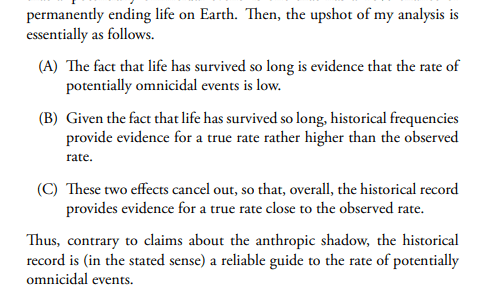This is a linkpost for Dispelling the Anthropic Shadow by Teruji Thomas.
Abstract:
There are some possible events that we could not possibly discover in our past. We could not discover an omnicidal catastrophe, an event so destructive that it permanently wiped out life on Earth. Had such a catastrophe occurred, we wouldn’t be here to find out. This space of unobservable histories has been called the anthropic shadow. Several authors claim that the anthropic shadow leads to an ‘observation selection bias’, analogous to survivorship bias, when we use the historical record to estimate catastrophic risks. I argue against this claim.
Upon a first read, I found this paper pretty persuasive; I'm at >80% that I'll later agree with it entirely, i.e. I'd agree that "the anthropic shadow effect" is not a real thing and earlier arguments in favor of it being a real thing were fatally flawed. This was a significant update for me on the issue.
Anthropic shadow effects are one of the topics discussed loosely in social settings among EAs (and in general open-minded nerdy people), often in a way that assumes the validity of the concept[1]. To the extent that the concept turns out to be completely not a thing — and for conceptual rather than empirical reasons — I'd find that an interesting sociological/cultural fact.


I'm having trouble understanding this. The part that comes closest to making sense to me is this summary:
Are they just applying https://en.wikipedia.org/wiki/Self-indication_assumption_doomsday_argument_rebuttal to anthropic shadow without using any of the relevant terms, or is it something else I can't quite get?
Also, how would they respond to the fine-tuning argument? That is, it seems like most planets (let's say 99.9%) cannot support life (eg because they're too close to their sun). It seems fantastically surprising that we find ourselves on a planet that does support life, but anthropics provides an easy way out of this apparent coincidence. That is, anthropics tells us that we overestimate the frequency of things that allow us to be alive. This seems like reverse anthropic shadow, where anthropic shadow is underestimating the frequency of things that cause us to be dead. So is the paper claiming that anthropics does change our estimates of the frequency of good things, but can't change our estimate of the frequency of bad things? Why would this be?
Ok great!
And ok, I agree that the answer to the first question is probably "yes", so maybe what I was calling an alternative anthropic principle in my original comment could be framed as SSA with this directly time-centric reference class. If so, instead of saying "that's not SSA", I should have said "that's not SSA with a standard reference class (or a reference class anyone seems to have argued for)". I agree that Bostrom et al. (2010) don't seem to argue for such a reference class.
On my reading (and Teru's, not coincidentally), the core insight Bostrom ... (read more)